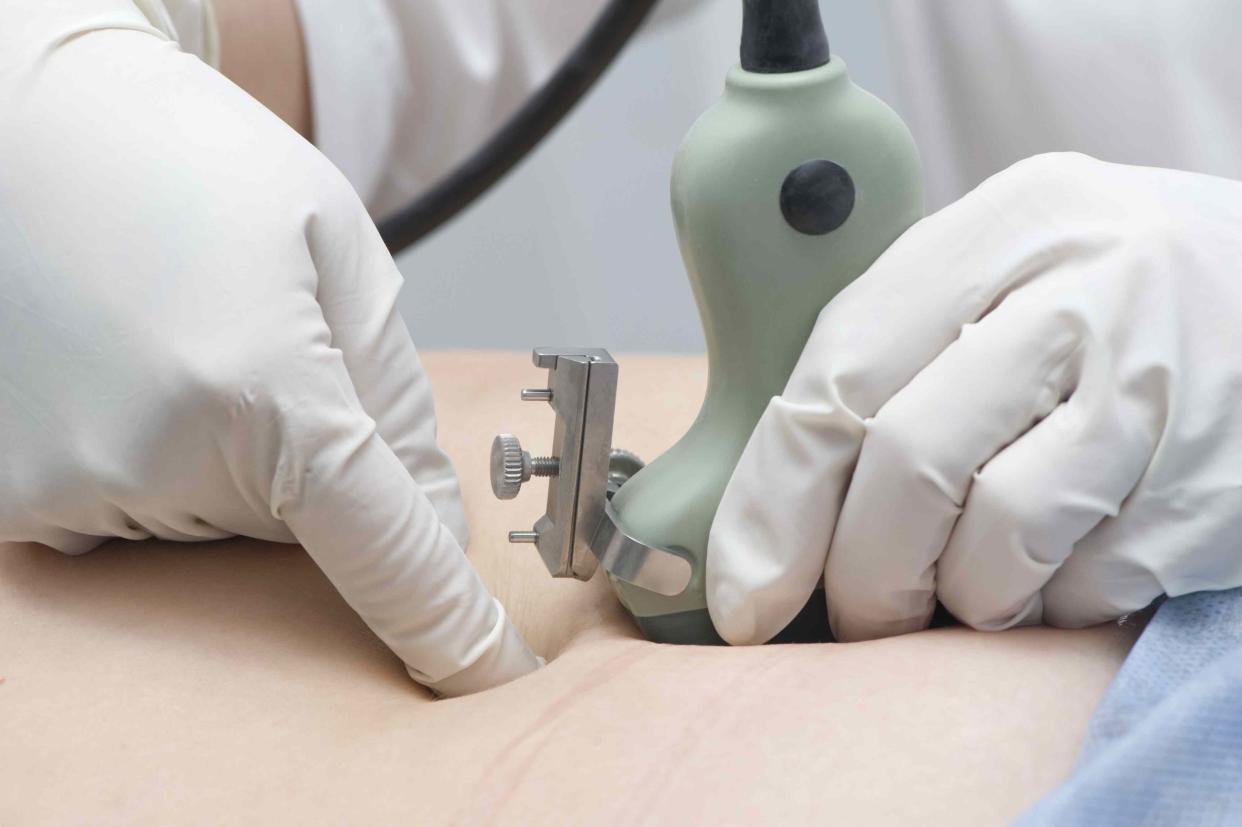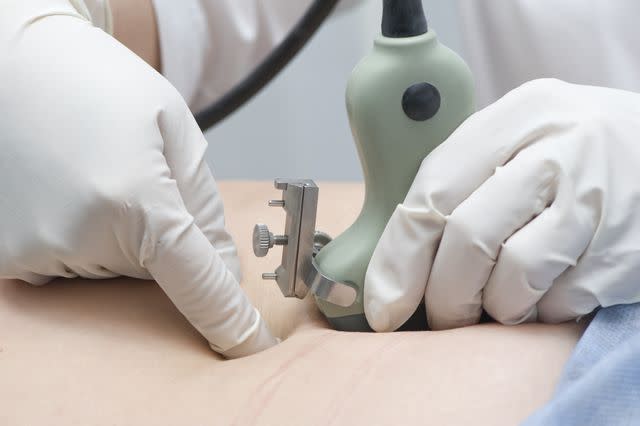What to Expect With Spina Bifida Occulta

zilli / Getty Images
Medically reviewed by Jonathan B. Jassey, DO
Spina bifida occulta is also known as hidden spina bifida. The term "spina bifida occulta" translates to "hidden split spine."
It is a birth defect (a health problem present at birth) that occurs when the spine and spinal cord do not form as they should. It prevents one or more bones of your spine from closing fully. The defect can occur at any point along the spine.
Spina bifida occulta is the mildest and most common form of spina bifida.
This article describes spina bifida occulta symptoms, causes, treatment, and outlook for those with it.

zilli / Getty Images
What Is Spina Bifida Occulta?
Spina bifida occulta—like all types of spina bifida—is a type of neural tube defect. A neural tube defect is a birth defect of the brain, spine, or spinal cord.
A baby's neural tube forms early in pregnancy and closes during the first month after conception. The top of the neural tube forms into the brain, and the rest develops into the spinal cord and structures around it.
In spina bifida, a gap forms between your spine's vertebrae (small bones). Spina bifida occulta is a mild type of this condition in which a small layer of skin covers the opening.
How Common Is Spina Bifida Occulta?
Approximately 12.4% of people have spina bifida occulta. Because the condition does not interfere with spinal function, most people do not know they have it.
Spina Bifida Occulta vs. Open Spina Bifida
Spina bifida occulta is a subtype of spina bifida that is described as "closed" because the gap in the spinal cord is covered by skin, fat, bones, or meninges (three layers of membranes that cushion the skull and spine). This type of spina bifida is typically asymptomatic because the spinal cord and nerves are usually normal.
Open spina bifida describes spinal cord defects in which a fluid-filled sac containing part of the spinal cord protrudes through the skin. This leaves the unprotected spinal cord vulnerable to injury and infection. It can also affect spinal cord function, severely limiting a person's mobility.
There are two types of open spina bifida. They are:
Myelomeningocele: The most serious type of spina bifida, melomeningocele is characterized by a sac of fluid that comes through an opening in the baby's back. This can cause damage to the spinal cord and nerves that result in moderate to severe disabilities with partial or complete paralysis below the opening and bladder and bowel dysfunction
Meningocele: This type of spina bifida is characterized by a sac of fluid that protrudes through the opening in the spine but does not contain the spinal cord. Damage that can range from few or no symptoms to paralysis and bladder and bowel dysfunction
Symptoms of Spina Bifida Occulta
Most people with spina bifida occulta do not have symptoms that require treatment. The condition is typically so mild that it does not interfere with normal spinal function.
However, about 1 in 1,000 people diagnosed with spina bifida occulta develop a more severe form of this condition. If you have this variety of the condition, you may experience one or more of the following neurological deficits or disabilities:
Deformities in the legs and/or feet
Muscle weakness, clumsiness, or numbness in your legs
Bowel or bladder dysfunction
Hand numbness or weakness
Scoliosis (a C-shaped or S-shaped curvature of the spine)
Skin abnormalities on the lower back:
Lesions, patches of hair, dimples, or fatty lumps
Hypopigmented spot (area of less skin color) on the lower back
Red or purple spot or hemangioma (benign growth of blood vessels)
Rarely, people with spina bifida occulta will have tethered cord syndrome (a spinal cord that can't move freely inside the spinal canal), which can also cause these symptoms. This condition occurs when tissue is attached to the cord and pulls the cord down, especially during times of growth. Without treatment, tethered cord syndrome can cause progressive neurological damage to your spinal cord.
Who Does Spina Bifida Occulta Affect?
It isn't clear why some babies are born with spina bifida occulta. Anyone can have the condition.
Certain genetic factors seem to increase the risk of a child having other types of neural tube defects. However, these factors may not be relevant to the development of spina bifida occulta because the problem can occur in people who do not have a family history of the condition.
Spina bifida affects about 1,427 babies annually, occurring in about 1 in every 2,758 births. The highest rate of spina bifida births occurs among Hispanic women. The number of pregnancies affected by spina bifida for each racial/ethnic group includes the following:
Hispanic: 3.80 per 10,000 live births
Non-Hispanic White: 3.09 per 10,000 live births
Non-Hispanic Black: 2.73 per 10,000 live births
Complications of Spina Bifida Occulta
Complications of spina bifida occulta are relatively rare. While complications do not occur often, the following problems can be present at birth or emerge over time with all types of spina bifida:
Tethered spinal cord
Paralysis (loss of ability to move)
Walking and mobility problems
Hydrocephalus (accumulation of fluid in the brain)
Frequent urinary tract infections (UTIs) and bowel problems
Learning and social challenges
Developmental disabilities
Orthopedic complications:, Scoliosis, abnormal growth, hip dislocation, bone and joint deformities, muscle contractures (stiffening of muscles)
Causes of Spina Bifida Occulta
You may be more likely to have a baby with spina bifida occulta if you have one of the following risk factors:
Took a seizure medicine like Depakote and Depakene (valproic acid) or Tegretol and Carbatrol (carbamazepine) during pregnancy
A history of other children or close family members born with spina bifida
Having obesity before pregnancy
Hyperthermia (increased body temperature)
Though a folic acid (vitamin B9) deficiency early in pregnancy increases the risk of other types of spina bifida, it may not affect your risk of having a baby with spina bifida occulta.
However, the March of Dimes advises that any woman who is planning a pregnancy or who could become pregnant should begin taking 400 mcg of folic acid (vitamin B9) daily and 600 mcg of folic acid during pregnancy as a preventive measure for all types of spina bifida.
How Spina Bifida Occulta Is Diagnosed
Spina bifida occulta can be diagnosed prenatally (before a baby is born). Since spina bifida occulta generally does not cause symptoms, most people with this condition are unaware of it. It is more commonly diagnosed as an incidental finding during an X-ray taken for an unrelated reason. As a result, many people aren't diagnosed with spina bifida occulta until late childhood or even adulthood.
Prenatal diagnosis of spina obifida occulta can be made by one of the following methods:
Maternal serum alpha fetoprotein (MSAP) screen: This blood test is taken at 16 to 18 weeks of pregnancy. It measures the level of a protein called alpha-fetoprotein (AFP), which can cross into the mother's bloodstream in the second trimester. A high level of AFP may indicate spina bifida. However, since most cases of spina bifida occulta are mild, there may be an inadequate level of AFP present to show up on the results.
Ultrasound: This is a medical imaging technique that uses sound waves to produce images of the fetus and placenta during pregnancy. In some cases, spina bifida occulta may be visible during an ultrasound of the baby. However, since spina bifida is "hidden," it may not be obvious in many cases during this type of test.
Amniocentesis: This involves the extraction of a small sample of the amniotic fluid (a fluid that surrounds the unborn baby). The results of this test can include higher than average levels of AFP in the fluid, though mild cases of spina bifida occulta may not produce enough AFP to indicate the presence of disease.
When symptoms occur or a skin disorder is present on the baby's back at birth or later in life, your healthcare provider may order one of the following tests to diagnose spina bifida occulta :
X-ray: This medical imaging technique uses small amounts of electromagnetic radiation to create images of structures inside your body.
Magnetic resonance imaging (MRI): This scan produces detailed two-dimensional (2D) or three-dimensional (3D) images of the structures inside your body. It uses a strong magnetic field and radio waves to give detailed views of your skeleton, organs, and tissues.
Computed tomography (CT) scan: This uses multiple X-rays to create 3D images of tissues, organs, and skeletal structures.
How Spina Bifida Occulta Is Treated
Since spina bifida occulta typically doesn't cause symptoms, treatment usually isn't required. When symptoms exist, they vary by individual. While some cases of open spina bifida may be treated with prenatal surgery, spina bifida occulta generally does not require treatment in this way.
Based on the conditions present, the following treatments may be used for spina bifida occulta after birth:
Endoscopic third ventriculostomy (ETV) surgery (surgery that creates an opening in the flow of the third ventricle of the brains to allow CSF fluid to drain) or placement of a shunt in the brain (surgeries to drain fluid from the brain)
Tethered cord release surgery (release of the spinal cord from the surrounding spine so it can move freely)
Surgery to improve the alignment of deformed feet, legs, or spine
One or more of the following assistive devices to support mobility: braces, walkers, crutches, wheelchairs
Physical therapy to help those affected maximize their strength and function
Treatment for bladder and bowel dysfunction, including medication or surgeries to prevent potential kidney failure
Does Spina Bifida Occulta Qualify You for Disability?
Being diagnosed with spina bifida occulta does not automatically qualify you for disability. The determination of disability is based on medical and other information about whether or not you meet established criteria.
The Americans with Disabilities Act (ADA) defines a person with a disability as meeting the following criteria:
A physical or mental impairment that substantially limits one or more major life activities
A history or record of such an impairment
Being perceived by others as having such an impairment
To qualify for federal disability insurance, you must meet the criteria proving you have an impairment as established by the Social Security Administration (SSA).
Outlook for Spina Bifida Occulta
Spina bifida affects everyone differently. Since symptoms of spina bifida occulta can be mild or nonexistent, you can have this condition and never know it exists. Treatment or lifestyle modifications may never be necessary.
Most people with spina bifida occulta have healthy nerves and spines. In these cases, you can expect to have a normal life span with no impact of the disease on your life expectancy.
While treatments can help relieve symptoms when they occur, there is no cure for spina bifida occulta.
Summary
Spina bifida occulta is a neural tube birth defect. Its name means closed split spine. It is the mildest form of spina bifida, a birth defect in which one or more bones in your spine do not close fully as the spine forms.
It is described as a closed form of spina bifida. Most cases of spina bifida involve the growth of a fluid-filled sac that pushes through the gap in the spine. In spina bifida occulta, the gap is hidden or closed because it is wrapped in skin.
While there is no cure for spina bifida occulta, the problem rarely causes symptoms. Many people have this problem at birth and live a full life, never knowing a health issue exists.
This problem is often found by chance during an X-ray of the back for other reasons. When symptoms occur, treatment can ease their effects.

